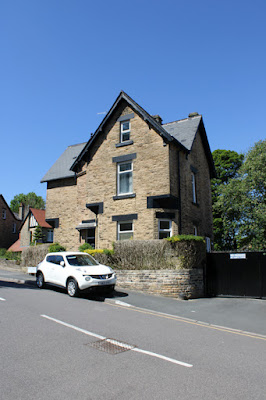 |
| A headstop at No.16 Highnam Cresecent Road |
On the next leg of my walk to further investigate the Sheffield Board Schools, from Crookesmoor Board School I crossed over the road to photograph the old vestry hall and caretaker’s house for the British Listed Buildings website before heading up Crookesmoor Road towards Crookes Road.
Although this wasn’t evident on the ground, I immediately crossed a fault, where the strata to its east side have been downthrown and the Grenoside Sandstone is brought into contact with an outcrop of the older Loxley Edge Rock.
Continuing up the hill to the road junction, the imposing Grade II Listed Crookes Valley Methodist Church and adjoining school already had a photograph on the British Listed Buildings website but, as this was quite old and I thought that I could do better, I took a general photo of its west end.
Except for the stone detailing to the former Unitarian Church, which had an apple carved in the gritty sandstone gate pier, the sandstone terraced houses and larger villas didn’t attract my attention, although views along the side roads confirmed the continued steep dip of the strata in the vicinity and, occasionally, I could see a steep drop to the east.
Deviating off Crookesmoor Road onto Highnam Crescent Road, to photograph a Grade II Listed sewer gas lamp, the houses here are mostly Victorian detached houses or semi-detached villas in the Gothic Revival style.
I was interested to see that the detached house at No.16, named Ravens, has a recessed arched doorway with a hoodmould that ends with headstops in the form of a king and a queen. As when investigating Crookes a few months earlier, I thought that these might be sculptures that were made speculatively and advertised in catalogues, which was quite common practice with building products in the C19.
I didn’t spend any time looking at the various sandstones used here, except to note that the Ravens inscription on the gate pier to No.16 is carved in a gritty sandstone that is much more coarse than that used for the walling and headstops.
With the Bole Hill quarries in nearby Crookes being by far the largest suppliers of building stone in this part of Sheffield, it is very likely that the Crawshaw Sandstone has been used for most of the later Victorian housing developments in the district.








No comments:
Post a Comment